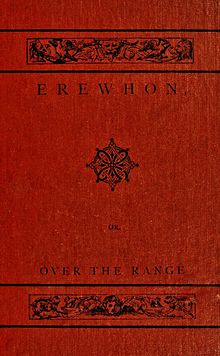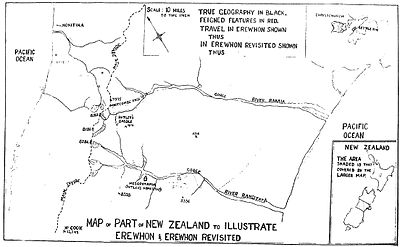Erewhon: or, Over the Range(/ɛrɛhwɒn/[2]) is a novel by English writerSamuel Butler,first published in 1872,[3]set in afictional countrydiscovered and explored by the protagonist. The book is a satire onVictoriansociety.[4]
 First edition cover | |
| Author | Samuel Butler |
|---|---|
| Language | English |
| Genre | Satire,Science fiction[1] |
| Publisher | TrübnerandBallantyne |
Publication date | 1872 |
| Publication place | United Kingdom |
| Pages | 246 |
| OCLC | 2735354 |
| 823.8 | |
| LC Class | PR4349.B7 E7 1872 c. 1 |
| Followed by | Erewhon Revisited |
| Text | Erewhononline |

The first few chapters of the novel dealing with the discovery of Erewhon are based on Butler's own experiences inNew Zealand,where, as a young man, he worked as asheep farmeronMesopotamia Stationfor four years (1860–1864), exploring parts of the interior of theSouth Islandand writing about it inA First Year in Canterbury Settlement(1863).
The novel is one of the first to explore ideas ofartificial intelligence,as influenced byDarwin'srecently publishedOn the Origin of Species(1859) and the machines developed out of theIndustrial Revolution(late 18th to early 19th centuries). Specifically, it concerns itself, in the three-chapter "Book of the Machines", with the potentially dangerous ideas ofmachine consciousnessandself-replicating machines.
Content
editThe greater part of the book consists of a description of Erewhon. The nature of this nation is intended to be ambiguous[citation needed].At first glance, Erewhon appears to be autopia,yet it soon becomes clear that this is far from the case. Yet for all the failings of Erewhon, it is also clearly not adystopia,such as that depicted inGeorge Orwell'sNineteen Eighty-Four(1949).
As asatiricalutopia,Erewhonhas sometimes been compared toGulliver's Travels(1726), byJonathan Swift;the image of Utopia in this latter case also bears strong parallels with the self-view of theBritish Empireat the time. It can also be compared to theWilliam Morrisnovel,News from Nowhere(1890) andThomas More'sUtopia(1516).
Erewhonsatirises various aspects ofVictorian society,including criminal punishment, religion, andanthropocentrism.For example, according to Erewhonian law, offenders are treated as if they were ill, whereas ill people are looked upon as criminals. Another feature of Erewhon is the absence of machines; this is due to the widely shared perception by the Erewhonians that machines are potentially dangerous.
The Book of the Machines
editButler developed the three chapters ofErewhonthat make up "The Book of the Machines" from a number of articles he had contributed toThe Press,which had just begun publication inChristchurch,New Zealand, beginning with "Darwin among the Machines"(1863). Butler was the first to write about the possibility thatmachines might develop consciousnessbynatural selection.[5]
Many dismissed this as a joke, but, in his preface to the second edition, Butler wrote, "I regret that reviewers have in some cases been inclined to treat the chapters on Machines as an attempt to reduce Mr Darwin's theory to an absurdity. Nothing could be further from my intention, and few things would be more distasteful to me than any attempt to laugh at Mr Darwin."
Characters
edit- Higgs—The narrator who informs the reader of the nature of Erewhonian society.
- Chowbok (Kahabuka)—Higgs' guide into the mountains; he is a native who greatly fears the Erewhonians. He eventually abandons Higgs.
- Yram—The daughter of Higgs' jailer who takes care of him when he first enters Erewhon. Her name is Mary spelled backwards.
- Senoj Nosnibor—Higgs' host after he is released from prison; he hopes that Higgs will marry his elder daughter. His name is Robinson Jones backwards.
- Zulora—Senoj Nosnibor's elder daughter—Higgs finds her unpleasant, but her father hopes Higgs will marry her.
- Arowhena—Senoj Nosnibor's younger daughter; she falls in love with Higgs and runs away with him.
- Mahaina—A woman who claims to suffer fromalcoholismbut is believed to have a weak temperament.
- Ydgrun—The incomprehensible goddess of the Erewhonians. Her name is an anagram of Grundy (fromMrs. Grundy,a character inThomas Morton's playSpeed the Plough).
Reception
editIn 1873, the reviewer in theDunedinnewspaper theOtago Witnessdeclared thatErewhonwas the best English satirical fiction sinceGulliver's Travels(1726).[6]
In a 1945 broadcast,George Orwellpraised the book and said that when Butler wroteErewhonit needed "imagination of a very high order to see that machinery could be dangerous as well as useful". He recommended the novel, though not its sequel,Erewhon Revisited.[7]
Influence and legacy
editDeleuze and Guattari
editThe French philosopherGilles Deleuzeused ideas from Butler's book at various points in the development of his philosophy of difference. InDifference and Repetition(1968), Deleuze refers to what he calls "Ideas" as "Erewhon". "Ideas are not concepts", he argues, but rather "a form of eternally positive differentialmultiplicity,distinguished from the identity of concepts. "[8]"Erewhon" refers to the "nomadic distributions" that pertain tosimulacra,which "are notuniversalslike thecategories,nor are they thehic et nuncornowhere,the diversity to which categories apply in representation. "[9]"Erewhon", in this reading, is "not only a disguisedno-wherebut a rearrangednow-here."[10]
In his collaboration withFélix Guattari,Anti-Oedipus(1972), Deleuze draws on Butler's "The Book of the Machines" to "go beyond" the "usual polemic betweenvitalismandmechanism"as it relates to their concept of"desiring-machines":[11]
For one thing, Butler is not content to say that machines extend theorganism,but asserts that they are really limbs and organs lying on thebody without organsof a society, which men will appropriate according to their power and their wealth, and whose poverty deprives them as if they were mutilated organisms. For another, he is not content to say that organisms are machines, but asserts that they contain such an abundance of parts that they must be compared to very different parts of distinct machines, each relating to the others, engendered in combination with the others... He shatters the vitalist argument by calling in question the specific or personal unity of the organism, and the mechanist argument even more decisively, by calling in question the structural unity of the machine.
Other References
editAgatha ChristiereferencesErewhonin her novelDeath on the Nile(1937).
A copy ofErewhonfigures inElizabeth Bowen's short story "The Cat Jumps" (1934).
Karl Popper's bookThe Open Society and Its Enemies(1945), includes and epigraph fromErewhonthat reads, "It will be seen... that the Erewhonians are a meek and long-suffering people easily led by the nose, and quick to offer up common sense at the shrine of logic, when a philosopher arises among them who carries them away... by convincing them that their existing institutions are not based on the strictest principles of morality."[12]
Alan M. TuringreferencesErewhonin his posthumously published paper, "Intelligent Machinery, A Heretical Theory" (c. 1951). He writes, "At some stage therefore we should have to expect the machines to take control, in the way that is mentioned in Samuel Butler's Erewhon."[13]
Aldous Huxleyalludes toErewhonin his novelsThe Doors of Perception(1954) andIsland(1962).
In his book,A Testament(1957),Frank Lloyd Wrightmistakenly attributes the origin of the termUsoniaas an alternate name for theUnited States of Americato Samuel Butler inErewhon.
The "Butlerian Jihad"is the name of the crusade to wipe out" thinking machines "in theFrank Herbert's novel,Dune(1965).[14]
Erewhon Marketis the name of an upscale Los Angeles-based natural foods grocery chain originally founded in Boston in 1966.[15]
C.S. Lewisalludes toErewhonin his essay, "The Humanitarian Theory of Punishment."[16]
The movieThe Day of the Dolphin(1973) features a boat named the Erewhon.[citation needed]
"Erewhon" is the unofficial name US astronauts give Regan Station, a military space station inDavid Brin'snovelEarth(1990).[17]
In 1994, a group of ex-Yugoslavianwriters inAmsterdam,who had established thePEN centre of Yugoslav Writers in Exile,published a single issue of the literary journalErewhon.[18]
In the graphic novelBye Bye, Earth(2000), Belle's sword is called "Erehwon", and the story makes reference to the novelErewhon.
New Zealand sound art organization, the Audio Foundation, published in 2012 an anthology edited byBruce RussellnamedErewhon Callingafter Butler's novel.[19]
In 2014,New ZealandartistGavin Hipkinsreleased his first feature film, titledErewhonand based on Butler's book. It premiered at theNew Zealand International Film Festivaland theEdinburgh Art Festival.[20]
In "Smile",the second episode of the 2017 season ofDoctor Who,the Doctor and Bill explore a spaceship namedErehwon.Despite the slightly different spelling, the episode writerFrank Cottrell-Boyceconfirmed[21]that this was a reference to Butler's novel.
Erewhon is the name of an independent speculative fiction publishing company[22]founded in 2018 byLiz Gorinsky.[23]
In the 2019Ubisoftvideo gameTom Clancy's Ghost Recon Breakpoint,"Erewhon" is the name for the world's settler hideout and players' online hub.[24]
A copy of Erewhon figures prominently in the video for "A Barely Lit Path," the lead single fromOneohtrix Point Never's 2023 albumAgain.[25]
See also
edit- Rangitata River– the location of the Erewhon sheep station named by Butler who was the first white settler in the area and lived at the Mesopotamia Sheep Station
- Nacirema– another piece of satirical writing with a similar backwards pun
References
edit- ^Canavan, Gerry (2018).The Cambridge History of Science Fiction.Cambridge University Press. pp. 57, 76–77.ISBN978-1-31-669437-4
- ^The title is an anagram of the word "nowhere." In the preface to the first edition of his book, Butler specified that "The Author wishes it to be understood that Erewhon is pronounced as a word of three syllables, all short—thus, Ĕ-rĕ-whŏn." Nevertheless, the word is occasionally pronounced with two syllables as "air-hwun" or "air-one".
- ^Erewhon, or Over the Range(1st ed.). London: Trubner & Co. 1872.Retrieved5 March2016– via Internet Archive.
- ^George Orwell,Erewhon,BBC Home Service, Talks for Schools, 8 June 1945
- ^"Darwin among the Machines",reprinted in the Notebooks of Samuel Butler atProject Gutenberg
- ^"Review".Otago Witness:28. 10 May 1873.
- ^Orwell,Collected Works,"I Belong to the Left", pp. 172–173.
- ^Deleuze (1968, p. 288).
- ^Deleuze (1968, p. 285).
- ^Deleuze (1968, p. 333, n.7).
- ^Deleuze and Guattari (1972, pp. 312–314).
- ^Karl Raimund Popper,The Open Society and Its Enemies: The Spell of Plato. Vol. 1,(Princeton University Press) 1971.
- ^Turing, Sara (2012).Alan M. Turing: Centenary Edition.Cambridge University Press. p. 157.ISBN978-1107020580.
- ^"The Butlerian Jihad and Darwin among the Machines".Archived fromthe originalon 5 August 2021.
- ^"History of Erewhon – Natural Foods Pioneer in the United States (1966-2011)"(PDF).Soy Info Center.Retrieved21 December2019.
- ^C.S. Lewis, Walter Hooper, ed.God in the Dock; Essays on Theology and Ethics,(Grand Rapids, Michigan: Eerdmans) 1970. Also: C.S. Lewis, "The Humanitarian Theory of Punishment,"Issues in Religion and PsychotherapyVol. 13: No. 1, Article 11. Available at:https://scholarsarchive.byu.edu/irp/vol13/iss1/11
- ^"DAVID BRIN: Earth".
- ^Erewhon;Blagojevic, Slobodan, et al.
- ^Hayes, Craig (8 October 2012)."Crooked Sounds from Aotearoa 'Erewhon Calling: Experimental Sound in New Zealand".PopMatters.Retrieved5 December2017.
- ^"Review of 'Erewhon'".CIRCUIT.19 September 2014.Retrieved12 June2016.
- ^"Frank Cottrell-Boyce on Twitter".Retrieved21 May2017– via Twitter.
- ^"Erewhon Books".
- ^"New Science Fiction and Fantasy Publisher Founded by Former Tor Books Editor".The Hollywood Reporter.17 October 2018.Retrieved17 October2018.
- ^Introducing AI Teammates to Tom Clancy's Ghost Recon Breakpoint,11 July 2020,retrieved21 January2025
- ^Oneohtrix Point Never – A Barely Lit Path,29 August 2023,retrieved29 August2023
- "Mesopotamia Station", Newton, P. (1960)
- Acland, Leopold George Dyke (1946).The Early Canterbury Runs: Containing the First, Second and Third (new) Series.Christchurch: Whitcombe and Tombs Limited.
- "Samuel Butler of Mesopotamia", Maling, P. B. (1960)
- "The Cradle of Erewhon", Jones, J. (1959)